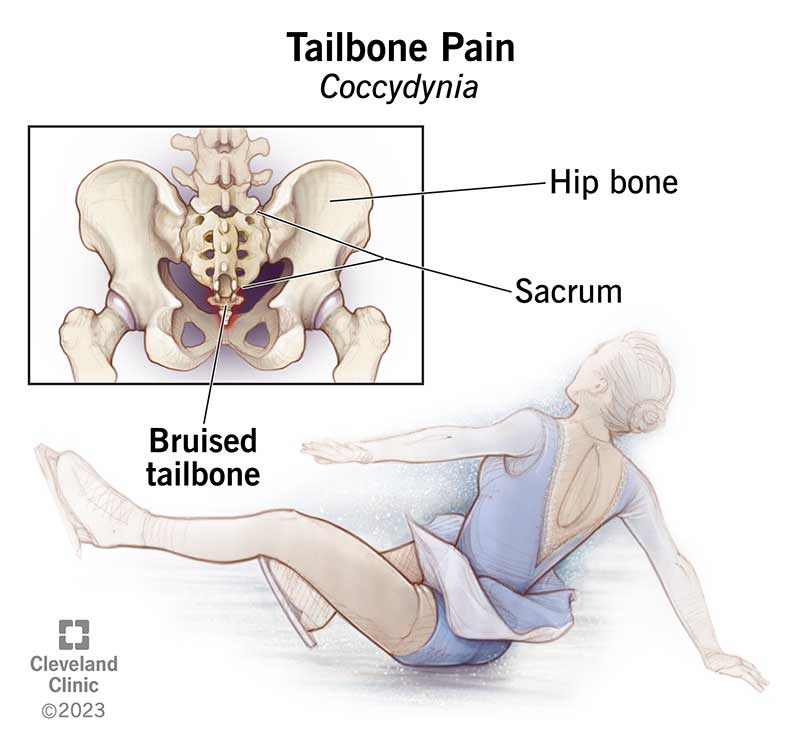Tailbone pain can make life uncomfortable at best and unbearable at worst. Your coccyx, a small triangular bone at the bottom of your spinal column, can get bruised or even fractured. Home remedies like medication and ice packs usually ease symptoms. But in some cases, you might need treatment like numbing injections or, very rarely, surgery.
Advertisement
Cleveland Clinic is a non-profit academic medical center. Advertising on our site helps support our mission. We do not endorse non-Cleveland Clinic products or services. Policy

“Coccydynia” is the medical term for tailbone pain (“coccyx” = tailbone, “dynia” = pain). Your coccyx (tailbone) is at the very bottom of your spine, and it consists of three to five fused vertebrae (bones).
Advertisement
Cleveland Clinic is a non-profit academic medical center. Advertising on our site helps support our mission. We do not endorse non-Cleveland Clinic products or services. Policy
Your tailbone has a few important jobs. When you sit down, it helps steady you and support your weight. It’s also where several tendons, ligaments and muscles in your body connect. But when your tailbone hurts, it’s a real pain in the rear — and it can interfere with daily routines and quality of life.
Tailbone pain is common. It’s five times more likely to occur in females than males. Adolescents and adults get it more often than children.
Coccydynia symptoms may include:
Other related symptoms that may occur in people with tailbone pain include:
There are many reasons why you might develop tailbone pain. Possible tailbone pain causes include:
Advertisement
In very rare cases, tailbone pain may be a sign of cancer near your coccyx or metastatic cancer that’s spread to your bones. This is very uncommon.
Cancers most likely to cause tailbone pain include:
If a tumor causes tailbone pain, additional cancer symptoms may include:
First, a healthcare provider will review your medical history. They’ll ask about any past injuries or trauma to your tailbone area like falls or a difficult childbirth. Next, they’ll examine the area to check for fractures, lumps or abscesses (pockets of infection).
To check for a fracture, your healthcare provider may recommend an:
To check for inflammation, abscesses or tumors, your provider may take an:
Tailbone pain treatment depends on the cause and the severity of your discomfort. Home remedies might be all you need. But if home remedies don’t work, your provider may recommend nonsurgical or surgical treatments.
In 90% of cases, people with tailbone pain find relief with home remedies. Here are some things you can try:
If home remedies don’t work, or if your pain keeps coming back, your provider might recommend nonsurgical treatments, like:
In extremely rare instances, your provider may recommend:
Recovery time from a coccygectomy can take several months. Even after a surgeon removes the bone, there’s no guarantee that your pain will go away. For this reason, providers only recommend coccygectomy when other treatments don’t work.
You might have other symptoms in addition to tailbone pain, especially with chronic coccydynia. If you develop conditions like depression or anxiety, it’s important to get treatment for these issues, too. Ignoring these symptoms can have a negative impact on your quality of life.
Advertisement
Tailbone pain usually goes away on its own in a few days with the help of home remedies and a little bit of patience. It can take a little longer for more severe injuries.
But if you have tailbone pain that doesn’t go away (chronic coccydynia), your healthcare provider can do an exam to determine why.
You can’t always prevent tailbone pain because it often occurs after accidents or as a symptom of an underlying condition.
You might be able to reduce your risk if you:
There are also things you can do to reduce your risk of falls:
Tailbone pain can be annoying, but most of the time it doesn’t indicate a serious health issue. However, you should call a healthcare provider if you have:
A healthcare provider can give you a diagnosis and help you find appropriate treatment.
Advertisement
Here are some questions you may want to ask your provider during your appointment:
Tailbone pain often goes away in a few days. But it can quickly become an unwanted guest. If tailbone pain lasts longer than a few weeks, or if it interferes with daily routines, it’s time to make an appointment. To learn more about how to relieve tailbone pain, talk to a healthcare provider.
Advertisement
Need care fast? Cleveland Clinic’s Express Care and Urgent Care locations treat everything from sprains to sinus infections — no appointment needed.

Last reviewed on 08/14/2023.
Learn more about the Health Library and our editorial process.